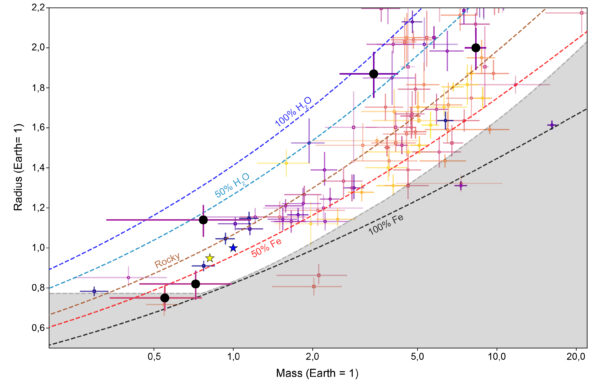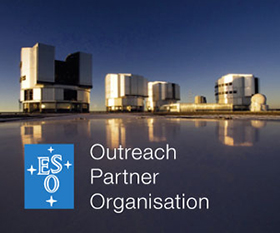Led by researchers at Instituto de Astrofísica e Ciências do Espaço, the discovery of these two exoplanets in the same system provides clues about how planets like Mercury are formed.
While observing the star system HD 23472 with the ESPRESSO1 spectrograph (ESO), a team2 led by Instituto de Astrofísica e Ciências do Espaço’s (IA3) researcher Susana Barros (IA & Dep. de Física e Astronomia – Faculdade de Ciências da Universidade do Porto), found three super-earths and two super-mercuries4. This last type of exoplanet is still very rare – counting these two, there are only eight known super-mercuries.
The objective of the study5, published today in the journal Astronomy & Astrophysics, was to characterize the composition of small planets and understand how it changes with the planet’s position, temperature and the stellar properties. Susana Barros explains that the team aimed to: “study the transition between having or not having an atmosphere, which could be related to the evaporation of the atmosphere due to the irradiation of the star.”
“The team found that this system is composed of three super-Earths with a significant atmosphere and surprisingly two Super-Mercuries, which are the closest planets to the star.” concludes Susana Barros.
Of the five planets in the HD 23472 system, three have masses smaller than the Earth. These are among the lightest exoplanets whose masses were measured using the radial velocity method6, which was only possible due to the very high precision of ESPRESSO, installed in ESO’s Very Large Telescope (VLT), in Chile. And the presence of not one, but two super-mercuries, left the team wanting to go further.

The planet Mercury, in the Solar System, has a relatively larger core and relatively smaller mantle than the other planets, but we don’t know why. Some possible explanations involve a giant impact which removed part of the planet’s mantle or, because of its high temperature, part of Mercury’s mantle could have evaporated. Surprisingly, other exoplanets with similar characteristics, called super-mercuries, were recently found around other stars.
Barros adds: “For the first time we have discovered a system with two super-mercuries. This allows us to obtain clues about how these planets were formed, which could help us exclude some possibilities. For example, if an impact large enough to create a Super-Mercury is already very unlikely, two giant impacts in the same system seems very improbable. We still don’t know how these planets are formed but it appears to be connected to the composition of the parent star. This new system can help us find out”.
Member of the team Olivier Demangeon (IA & DFA-FCUP), comments : “Understanding how these two super-Mercuries have formed will require further characterization of the composition of these planets. As these planets have radii smaller than the Earth, current instrumentation does not have the sensitivity to probe the composition of their surface, or the existence and composition of a potential atmosphere. The future Extremely Large Telescope (ELT) and its first generation high resolution spectrograph ANDES7, will for the first time provide both the required sensitivity and precision to attempt such observations.”

But the ultimate goal is to find other Earth’s. “ The existence of the atmosphere gives us insight into the formation and evolution of the system and also has implications on the habitability of planets. I would like to extend this type of study to longer period planets which have more amenable temperatures”, says Barros.
IA’s participation in ESPRESSO is part of a broader strategy to promote exoplanet research in Portugal, by building, developing and defining several instruments and space mission, like ESA’s Cheops mission, already in orbit. This strategy will continue in the upcoming years, with the launch of ESA’s PLATO space telescope, Ariel mission, and the installation of the ANDES spectrograph in the largest telescope of the next generation, ESO’s ELT.
Notes
- The ESPRESSO spectrographis a high-resolution instrument that will enable the discovery of Earth-like exoplanets. ESPRESSO will also be the most powerful tool in the world to test if the physical constants of Nature have changed since the early ages of the Universe, as predicted by some fundamental theories of Physics.
- The team is: S. C. C. Barros, O. D. S. Demangeon, Y. Alibert, A. Leleu, V. Adibekyan, C. Lovis, D. Bossini, S. G. Sousa, N. Hara, F. Bouchy, B. Lavie, J. Rodrigues, J. Gomes da Silva, J. Lillo-Box, F. A. Pepe, H. M. Tabernero, M. R. Zapatero Osorio, A. Sozzetti, A. Suárez Mascareño, G. Micela, C. Allende Prieto, S. Cristiani, M. Damasso, P. Di Marcantonio, D. Ehrenreich, J. Faria, P. Figueira, J. I. González Hernández, J. Jenkins, G. Lo Curto, C. J. A. P. Martins, G. Micela, N. J. Nunes, E. Pallé, N. C. Santos, R. Rebolo, S. Seager, J. D. Twicken, S. Udry, R. Vanderspek e J. N. Winn.
- The Instituto de Astrofísica e Ciências do Espaço (Institute of Astrophysics and Space Sciences – IA) is the reference Portuguese research unit in this field, integrating researchers from the University of Lisbon, the University of Coimbra and the University of Porto, and encompasses most of the field’s national scientific output. It was evaluated as “Excellent” in the last evaluation of research and development units undertaken by Fundação para a Ciência e Tecnologia (FCT). IA’s activity is funded by national and international funds, including FCT/MCES (UIDB/04434/2020 e UIDP/04434/2020).
- Super-earths and super-mercuries are the higher mass analogs of the Earth and Mercury in terms of composition. The difference between the composition of an Earth-like planet to that of a Mercury-like planet is that “Mercuries” have a bigger iron content and iron core.
- The article “HD 23472: A multi-planetary system with three super-Earths and two potential super-Mercuries”, was published today in Astronomy & Astrophysics (DOI: 10.1051/0004-6361/202244293).
- The Radial Velocity method detects exoplanets measuring tiny variations in the (radial) velocity of the star, due to the motion that an orbiting planet induces in the star. As an example, the speed variation that the Earth imprints in the Sun is of about 10 cm/s (about 0.36 km/h). With this method you can set a minimum value for the planets’ mass.
- ANDES (ArmazoNes high Dispersion Echelle Spectrograph) is a spectrograph, which will be installed in the ELT (Cerro Armazones, Atacama desert, Chile). it will observe individual objects, both in visible light and infrared, with great accuracy. This will make possible the search for signs of life, through the study of exoplanetary atmospheres, study galaxy evolution and identify the first generation of stars, born in the early Universe, or determine if the Universal constants vary over time.
Contacts
Susana Barros, Olivier Demangeon, Nuno Cardoso Santos
Science Communication Group
Ricardo Cardoso Reis; Sérgio Pereira; Filipe Pires (coordenação, Porto); João Retrê (coordenação, Lisboa)


